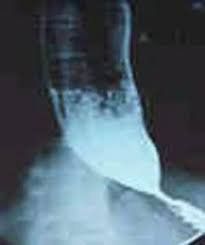This is an automatically translated article.
Throat cancer is cancer that originates in the lower pharynx. The cause of throat cancer is currently unknown. Tumor usually originates from the pear sinus, when cancer spreads along the pharynx larynx, it will rise to the oropharynx and spread to the posterior wall of the pharynx, oropharynx, larynx.
1. What is throat cancer?
Lower pharyngeal cancer is cancer that starts in the lower pharynx, if the cancer spreads into the larynx, it is called hypopharynx-laryngeal cancer. This is a very common form of cancer, second only to nasopharyngeal cancer in ENT cancers.
There are 3 most common types of pharynx cancer, including:
Cancer of the pleural sinuses Cancer of the posterior ring of the funnel Oral cancer of the esophagus: The cause of throat cancer is not clear yet. Some risk factors related to hypopharynx tumor include:
Smoking and alcoholism: the level of smoking is directly proportional to the incidence of throat cancer. In addition, prolonged drinking causes local irritation of the throat mucosa. Therefore, smoking and regular alcohol consumption are the main risk factors for hypopharyngeal tumors.

Thuốc lá là nguyên nhân hàng đầu gây ung thư hạ họng
Poor oral hygiene: Poor oral hygiene causes bacteria to thrive, causing chronic inflammation in the throat, creating favorable conditions to cause cancer of the throat. HPV virus: infection with the HPV virus increases the risk of nasopharyngeal cancer and throat cancer. Gastroesophageal reflux is also a risk factor for the disease. Plummer-Vinson syndrome: The telltale signs are dysphagia, iron deficiency anemia and esophageal mesh. The disease increases the rate of throat cancer. Environment: Working, living in polluted areas or workers exposed to asbestos and wood dust increase the risk of throat cancer.
2. Stages and progression of throat cancer
Cancer of pear sinus:
The most common sign of throat cancer in the pleural cavity is difficulty swallowing on one side or discomfort on one side of the throat, especially when swallowing saliva, this is a warning sign of throat cancer. early stage . After the first signs, the sensation of swallowing increases gradually and the pain in the ear becomes more and more obvious, possibly with mucus and blood in the mouth. After that, there were signs of difficulty speaking because the tumor had begun to spread into the pharynx and larynx wall. On examination, the cervical lymph nodes were palpated, because the clinical symptoms as well as the cervical lymph nodes of the early stage of pharyngeal cancer were quite different. discreet, less rambunctious or lasts too long.

Người bệnh có thể xuất hiện hạch ở cổ khi ở giai đoạn ung thư xoang lê
Cancer of the posterior ring of the funnel:
Tumor usually affects the medial wall and anterior angle of the pleural sinus, but most commonly spreads down to the oropharynx. At this stage, it is often difficult to detect where the tumor comes from. The most common symptom is difficulty swallowing, but this symptom is not overwhelming and progresses slowly. Inflammation is mild and edematous, and the posterior ring of the funnel is often slightly raised, n The early stage of hypopharynx cancer in the posterior region of the funnel often has not detected cervical lymph nodes. Oropharyngeal cancer:
Appears from below the mucosa to the lower pharynx and down the esophagus, can spread anteriorly into the trachea or thyroid gland. Spread into the larynx wall is usually at a late stage, causing the vocal cords to be fixed. The cervical lymph nodes are metastatic and palpable in the late stage.
3. Treatment and prevention of throat cancer
3.1. Throat cancer treatment
Throat cancer is a disease that still cannot be completely cured. Treatment measures for hypopharyngeal tumors include: surgery, radiation, chemotherapy and immunotherapy.
For surgical treatment of hypopharyngeal tumors: Considering the stage of the disease, appropriate surgery is indicated such as partial or total pharyngo-laryngectomy or with cervical lymph node dissection. For treatment of hypopharyngeal tumors with radiation: radiation therapy alone or adjuvant radiation therapy can be performed after surgery. For treatment of hypopharyngeal tumors with chemotherapy and immunotherapy: Used for systemic treatment in end stage nasopharyngeal cancer.

Phẫu thuật là một phương pháp điều trị ung thư hạ họng
3.2. Throat cancer prevention
To prevent throat cancer, some non-specific measures can be taken:
Give up alcohol and tobacco, as these are the two main risk factors for throat cancer. A balanced diet, avoiding malnutrition and vitamin deficiency. Eat healthy (lots of vegetables, fruits, whole grains), and limit red meat, processed foods. Prevent HPV infection with vaccines, safe sex. Clean oral hygiene, treat diseases of the nose and throat area thoroughly if any. Full labor protection, in accordance with regulations in hazardous chemical environment. Complete treatment of gastroesophageal reflux disease, if any. When symptoms such as hoarseness, difficulty breathing, difficulty swallowing appear, it is necessary to see an otolaryngologist to find out the cause of the disease.

Tiêm vắc-xin HPV giúp phòng chống ung thư hạ họng
Early cancer screening is considered a perfect measure in the timely detection and treatment of cancers. Reduce treatment costs and especially reduce patient mortality. Vinmec International General Hospital always deploys and introduces to customers HIGH-TECH CANCER CHECKLIST AND SCREENING PACKAGE for gene testing, imaging, and biomarkers for early tumor detection.
Vinmec International General Hospital has many early cancer screening packages. A single gene test can assess the risk of 16 common cancers in both men and women.
To register for examination and treatment at Vinmec International General Hospital, you can contact Vinmec Health System nationwide, or register online HERE.











